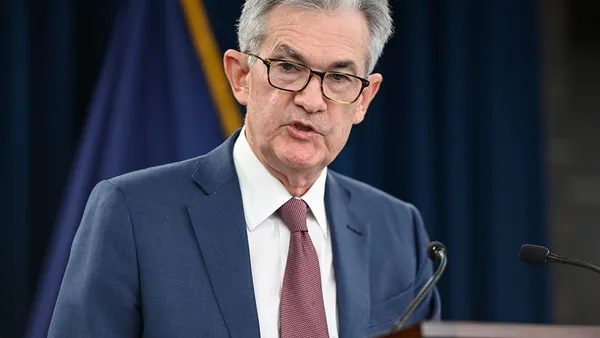Following a long winter, spring appears to be in the air for initial public offerings. U.S. IPOs raised $22.2 billion in 2023 — below the high of 2021 but a 157% jump from 2022’s deep market slump, according to a recent study by Big Four accounting firm Ernst & Young.
As inflation slows and other signs of light hit the murky economic environment, companies, investors and executives are becoming more optimistic about the coming IPO landscape. At the 11th annual IPO summit hosted last week by the Connor Group at the New York Stock Exchange, most attendees appeared to agree that “we're heading in the right direction” Sam Levy, senior vice president of growth and operations for NetSuite, who attended the summit, told CFO Dive.
However, while the market may be recovering, it’s taking a different shape than that of the past decade, Levy said together in an interview with Ranga Bodla, VP of field engagement and marketing for NetSuite.
Investors are less focused on growth-at-all costs and are seeking out companies with a longer runway that have demonstrated a path to profitability — unlike in past years, it’s unlikely that a company today will be rewarded for negative profitability, he said.
“I think most companies that are coming out today, they want a long-term event,” Levy said. “They want to go through an IPO … they've got to have some liquidity in that initial piece of it, but they don't want to overprice it, and they don't want to have a business model that declines [afterwards].”
Prepping for an IPO spring
An enterprise software provider which was bought by Oracle in 2016, NetSuite’s customers run the gamut from family-owned businesses to venture- or private equity-backed entities and public companies, Bodla said. For companies looking to go public, NetSuite’s platform can be tapped as the system where they can put in all of the necessary controls and tracking they need to create the right financial plan, he said.
Having that rigidity is crucial for pre-public companies, as today’s investors look for proof of profitability. While growth remains a factor, “the profit seems to be the high value ticket today,” Levy said.
Investors haven’t done a total about face from zero profit to zero growth either; “if you're not growing, you're profitable, that's not going to be rewarded, either,” Bodla said. “It's got to be efficient growth.”
Achieving that balance leaves companies that want to make the move to public looking to have the processes and controls they’re going to need as a public entity already at work when they are still private.
“I think what you're seeing with the pre-IPO, is private companies are acting like public companies before they enter the market,” Levy said.
Many are profitable before they set up for an IPO, running in a way that “shows a longer runway so that investors can stay in for the long haul,” Levy said.
Other companies may be moving back to a more sustainable “rule of 40” model — a growth metric originally popularized in the software world which states that a software company’s growth rate and profit margin, when added together, should exceed 40%.
Businesses are taking on such an approach as eyes — and more critically, funding — appear to be returning to the IPO market with more positivity. The theme of last week’s IPO Summit, notably, was “embracing optimism,” and drew attendees from 675 companies valued collectively at $850 billion, compared to the 700 companies who attended last year’s event with a value of $600 billion, according to posts by the Connor Group on LinkedIn.
That optimism is being driven through several factors, Levy said, such as resilience in the stock market, for example, as well as more clarity surrounding inflation and the game plan of the Federal Reserve as it looks to meet its 2% goal, for another. The central bank is now pivoting to considering when to cut interest rates after holding them steady during their most recent meeting, prompting rising optimism that the economy may skirt recession. Another potential factor that could bolster coming IPOs is that private equity firms, for one, “have a large treasure trove of dry powder,” Levy said.
“The deal flow has been nonexistent,” he said. “So a little bit of it is pent up demand, but now they can be picky and choosy with where they're going to place their dry powder, if you will.”
Driving efficient growth with AI
Another factor that could bolster the IPO market this year is the surge in interest surrounding artificial intelligence, particularly generative AI tools. Continued attention on GenAI tools could help to prop up flagging mergers and acquisitions dealmaking, CFO Dive previously reported, as executives and investors consider how to best put the technology to use.
“Every company is tasked to understand AI for their business,” Levy said. “I'm not sure every executive can explain it yet, how they're going to digest, or strategize and how they're going to execute on AI.”
Using AI won’t necessarily impact one’s IPO readiness, Bodla said. While many firms may be integrating GenAI tools into their businesses, the technology and its impact remains largely untested, raising questions that will need to be answered before GenAI-focused companies move to go public in a more wary IPO market.
“An IPO is the ultimate showcase to the market that, your books are perfect,” Bodla said regarding generative AI. “You don't want to make a restatement, you want to demonstrate credibility, to the market, so you can't afford to make mistakes. AI’s not quite there yet.”
However, the technology could be applied to help companies considering going public foster more efficient growth.
“If you're using AI primarily just to save costs…that's not going to really make a difference when it comes to going public,” Bodla said. “However, if I'm using AI, and now instead of growing 10%, I'm now growing 15% or growing 15% by 30%, that's a different conversation.”




















